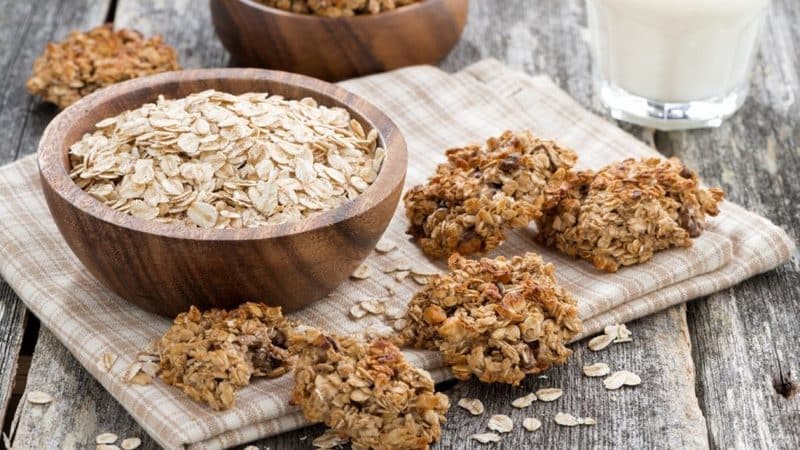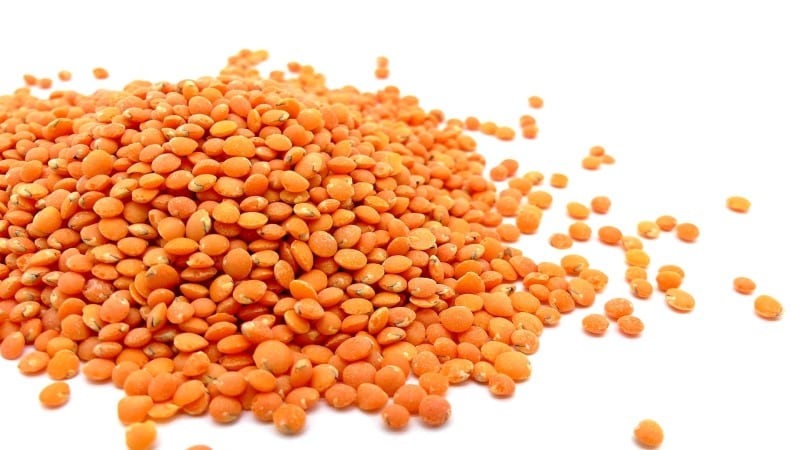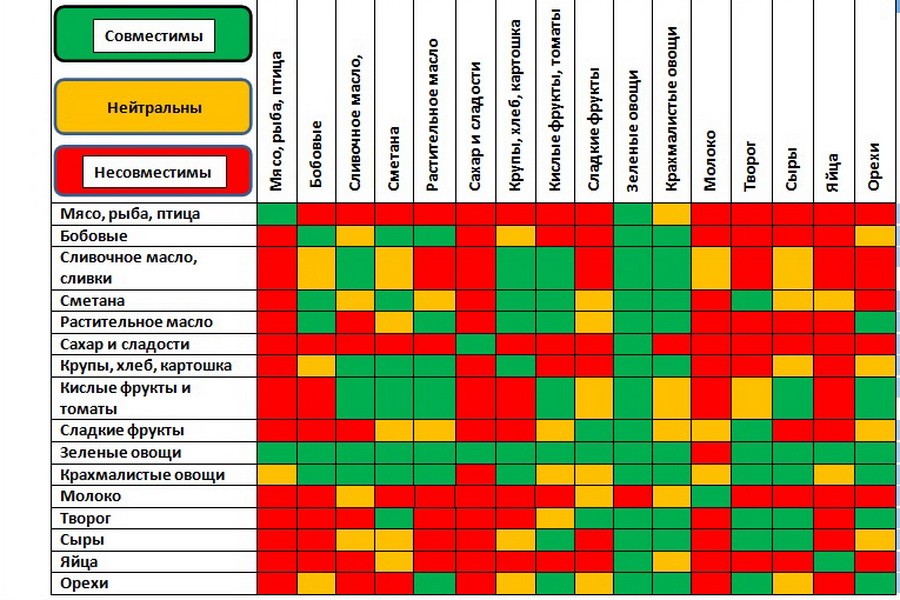Comparative analysis of which is healthier: buckwheat, lentils or oatmeal
Many of those who adhere to a healthy diet diligently avoid “fast” carbohydrates and prefer oatmeal or buckwheat porridge as a side dish or a hearty breakfast. But comparing these cereals with the less popular lentils does not speak in their favor.
In the article we will talk about the main differences in the chemical composition of products, their energy and nutritional value, health properties, consider contraindications to the consumption of buckwheat, oatmeal and lentils and the opinions of nutritionists on their account.
Chemical composition and trace elements
The properties of a product are determined by its chemical composition. Let's consider buckwheat, oatmeal and lentils from this point of view.
Buckwheat
The historical homeland of buckwheat is the Hindustan Peninsula, where it was cultivated no later than 4 thousand years ago. In Rus', the plant became widespread thanks to active trade with Byzantium, retaining a reference to Greek culture in its Slavic name.
Today buckwheat is available in several varieties:
- kernel - whole grains, peeled from the fruit shell and fried;
- prodel (cut) - chopped kernels;
- buckwheat flakes - flattened grains;
- Smolenskaya cereal - finely crushed buckwheat (grains up to 2 mm in diameter);
- green buckwheat - a product that has not been subjected to heat treatment.
100 g of buckwheat contains:
- starch - 55.4 g;
- fiber - 10.3 g;
- fatty acid:
- saturated - 0.6 g;
- unsaturated - 2.3 g.
- mono- and disaccharides - 1.4 g;
- vitamins:
- B1 - 0.2 mg;
- B2 - 0.3 mg;
- B3 - 5.1 mg;
- B4 - 54.2 mg;
- B5 - 1.2 mg;
- B6 - 0.4 mg;
- B9 - 42 mcg;
- H - 10 µg;
- PP - 7.2 mg;
- K - 7 mcg.
- minerals:
- calcium - 17 mg;
- potassium - 320 mg;
- phosphorus - 319 mg;
- magnesium - 221 mg;
- sodium - 11 mg;
- iron - 2.5 mg;
- manganese - 1.6 mg;
- zinc - 2.4 mg;
- copper - 0.6 mg;
- selenium - 8.4 mcg.
- essential amino acids:
- arginine - 0.87 g;
- leucine - 0.74 g;
- valine and lysine - 0.6 g each.
The phenolic compounds of buckwheat work as antioxidants and protect the grain during long-term storage from souring and mold formation.
Oatmeal

Oats are a cereal crop originally from Mongolia and the northeastern part of China, which has gained popularity in countries with temperate and cold climates due to its unpretentiousness: in the UK, Germany, and Russia.
The most commonly eaten food is oatmeal. According to the interstate standard GOST 21149-93, the following types are distinguished:
- Extra - flattened whole or cut first grade cereal. It is divided by numbers depending on the size of the flakes and their boilability (No. 1 - the largest, No. 3 - the smallest).
- Hercules is a premium pressed cereal.
- Petal flakes - are made from the same cereal as rolled oats, but have a grooved surface, so they boil faster.
Average chemical composition of 100 g of oatmeal:
- starch - 49 g;
- mono- and disaccharides - 1 g;
- dietary fiber, including beta-glucan and gluten - 8 g;
- saturated fatty acids - 1 g;
- vitamins:
- B1 - 0.8 mg;
- B2 - 0.1 mg;
- B3 - 1 mg;
- B5 - 1.3 mg;
- B6 - 0.1 mg;
- E - 3.2 mg;
- RR - 4.6 mg.
- minerals:
- phosphorus - 523 mg;
- potassium - 429 mg;
- magnesium - 177 mg;
- calcium - 54 mg;
- manganese - 4.9 mg;
- iron - 4.7 mg;
- zinc - 4 mg;
- sodium - 2 mg;
- copper - 0.6 mg;
- selenium - 28.9 mcg.
- essential amino acids:
- arginine - 0.85 g;
leucine - 0.71 g; - valine - 0.63 g;
- lysine - 0.47 g.
- arginine - 0.85 g;
Total 100 g oatmeal contain double the recommended amount of manganese, which is responsible for the strength of bone and connective tissue, as well as participating in metabolism.
Lentils

Lentils are the flat seeds of a plant of the same name in the legume family. Included in the human diet since the Bronze Age.
The most common varieties and varieties are:
- brown;
- green (plate);
- red - does not have a shell, so it takes only 10-15 minutes to prepare;
- black (“Beluga”) - resembles beluga caviar in shape, size and color, hence the name.
Chemical composition of lentils per 100 g of product:
- starch - 43-50 g;
- total sugar content - 2 g;
- fiber - 10.7 g;
- vitamins:
- A - 3 μg;
- C - 4.5 mg;
- B1 - 0.9 mg;
- B2 - 0.2 mg;
- B3 - 2.6 mg;
- B4 - 96.4 mg;
- B5 - 0.3-2.1 mg;
- B6 - 0.5 mg;
- B9 - 204-479 mcg;
- E - 0.5 mg;
- K - 5 mcg.
- minerals:
- potassium - 668 mg;
- phosphorus - 281 mg;
- magnesium - 59 mg;
- calcium - 48 mg;
- iron - 7.4 mg;
- sodium - 7 mg;
- zinc - 3.6 mg;
- manganese - 1.7 mg;
- copper - 1.3 mg.
- amino acids:
- arginine - 1.9 g;
- leucine - 1.8 g;
- valine - 1.2 g.
As a fraction of the recommended daily value, red lentils are the richest in copper. This substance is involved in iron metabolism and stimulates the absorption of proteins and carbohydrates.
Calorie content and dietary fat, glycemic index
Calorie content is the first thing people pay attention to lose weight. But the ratio of BZHU and the glycemic index is no less important.
Nutritional and energy value of buckwheat
Glycemic index of dry cereals - from 50 to 60. When boiled, due to water, the indicator decreases to 40-50.
| Per 100 g of product | Dry kernel | Boiled core | Prodel dry | Dry green buckwheat |
|---|---|---|---|---|
| Calorie content, kcal | 313 | 101 | 300 | 296 |
| Proteins, g | 12,6 | 4,2 | 9,5 | 10,8 |
| Fats, g | 3,3 | 1,1 | 2,3 | 3,2 |
| Carbohydrates, g | 62,1 | 18,6 | 60,4 | 55 |
Oatmeal
The glycemic index of oatmeal varies from 55 to 60, oatmeal with milk - 60, water - 40.
| Per 100 g of product | Dry oat flakes | Extra No. 1,2 | Extra No. 3 | Hercules | Oatmeal on water |
|---|---|---|---|---|---|
| Calorie content, kcal | 305 | 310 | 360 | 352 | 88 |
| Proteins, g | 11 | 16 | 16 | 12,3 | 3 |
| Fats, g | 6,2 | 10 | 10 | 6,2 | 1,7 |
| Carbohydrates, g | 50 | 40 | 50 | 62 | 15 |
Lentils
The glycemic index of dry lentils is from 38 to 41, of the finished product - 25.
| Per 100 g of product | Brown lentils | Red lentils | Black lentils | |||
|---|---|---|---|---|---|---|
| dry | boiled | dry | boiled | dry | boiled | |
| Calorie content, kcal | 297 | 105 | 318 | 100 | 324 | 145 |
| Proteins, g | 24,3 | 8,8 | 23,8 | 7,6 | 35 | 17 |
| Fats, g | 1,9 | 0,7 | 1,3 | 0,4 | 2 | 0,5 |
| Carbohydrates, g | 48,8 | 6,9 | 56,3 | 17,5 | 53 | 20 |
Which has more calories?
When prepared, buckwheat and lentils are higher in calories than oatmeal:
- boiled lentils - 105-145 kcal;
- buckwheat porridge on water - 101 kcal;
- oatmeal - 88 kcal.
Cooking oatmeal and buckwheat with milk increases the calorie content of porridges to 130 and 140 kcal, respectively. At the same time, milk buckwheat porridge is more dietary than cereal simply doused with milk. The energy value of this dish is 198 kcal.
What's best for losing weight
Oatmeal - a classic option for a hearty, high-carbohydrate breakfast, unless we are talking about instant cereals. In the latter case, fast carbohydrates are processed by the body in a short time, and the person feels hungry again.
Reference. Hollywood actress Anne Hathaway resorted to an oatmeal mono-diet in preparation for her Oscar-winning role in the film Les Misérables.
Despite the higher calorie content than oatmeal, lentils has a low glycemic index, i.e.does not cause a sharp jump in blood sugar, is rich in protein (from 8 to 17 g per 100 g of finished product), contains practically no fat and gives a long-lasting feeling of satiety, therefore it is effective in the fight against excess weight. It is a favorite among vegetarians as an alternative to meat.
Buckwheat often included in therapeutic diets on medical advice (diet tables). It is also used as a mono-diet for weight loss (for example, with the addition of kefir). The kernel steamed with boiling water is healthier than other varieties, since it preserves the entire set of microelements and vitamins.
Is it possible to combine buckwheat and oatmeal, buckwheat and lentils?
Apologists for separate nutrition allow combining foods containing starch with each other if the amount of protein in them is approximately the same. Buckwheat and oatmeal meet this requirement.
From a culinary point of view, such a combination is possible if the cereals are processed into flakes and require the same amount of time to cook. Otherwise, you will end up with a dish with an unpleasant consistency and taste.
According to the food compatibility table, cereals and legumes provide a neutral combination. In vegetarian and lenten menus, recipes for dishes made from buckwheat and lentils with the addition of various vegetables or mushrooms are popular.

Beneficial properties for the body
When used correctly, the products in question have a healing effect on the body.
Buckwheat
Eating buckwheat dishes has a positive effect on various diseases. The grain product owes these properties to a number of useful substances:
- Choline (vitamin B) is necessary for the proper functioning of the nervous system and brain function.
- Polyunsaturated fats - participate in metabolism in the body and lower cholesterol levels in the blood.
- Routine - restores the density of blood vessels and normalizes blood clotting. On an industrial scale, it is obtained from buckwheat shoots for the production of pharmacological drugs: “Urutin”, “Rutamin”, “Ascorutin”, etc.
- Magnesium - works as a natural antidepressant, relieves fatigue, helps cope with stress. The substance is also used to prevent varicose veins and swelling.
- Fiber - normalizes the functioning of the gastrointestinal tract, reduces blood glucose levels.
In Eastern medicine, buckwheat porridge in combination with pomegranate juice or sauce is known as an effective remedy for anemia.
Oatmeal
The beneficial properties of oatmeal are determined by its rich composition:
- Antioxidants increase the body's resistance to various infections and negative environmental influences.
- Phosphorus and calcium are necessary for the normal formation and development of the skeletal system.
- Iron prevents anemia.
- Biotin (B vitamin) prevents dermatitis and has a positive effect on the skin.
- Beta-glucan reduces bad cholesterol levels.
- Fiber maintains optimal blood sugar levels.
Oatmeal coats the gastric mucosa, has an anti-inflammatory effect, and therefore prevents pain and bloating. Cereal helps cleanse the intestines and improves peristalsis.
Lentils
Lentils are a real storehouse of vitamins, minerals and amino acids:
- Thanks to its iron content, it helps with hematopoiesis. To enhance the absorption of this element, lentil dishes are combined with fresh vegetables rich in vitamin C (tomatoes, red peppers, fresh herbs).
- One serving of the finished product contains 90% of the recommended daily intake of folic acid needed by pregnant women.
- Magnesium and potassium are important for the normal functioning of the heart and nervous system.
- The amino acid tryptophan is processed in the human body into serotonin, known as the “happiness hormone”.
- Isoflavones suppress breast cancer.
Soluble fiber in lentils improves digestion, stimulates metabolism, and has a positive effect on the microflora in the intestines, thereby increasing immunity. Lentil puree is recommended for stomach and duodenal ulcers, and the decoction is useful for urolithiasis.
From a Chinese medicine perspective, lentils are a warming food. Enhance its warming effect with the help of spices. Spicy lentil soup is indispensable in the winter diet of residents of northern countries.
Important! A serving of lentils twice a week significantly reduces blood glucose levels in patients with diabetes.
Which is healthier?
Buckwheat, oatmeal and lentils have unique properties, so it is difficult to clearly judge which is healthier. But lentils are a product that retains its qualities even during the process of preservation and heat treatment. It also surpasses the cereals in question in terms of the amount of B vitamins, contains a lot of protein and has a low glycemic index.
Harm and possible contraindications for use
“Everything is poison, and everything is good,” said the ancient sages. This judgment is also true for buckwheat, oatmeal and lentils.
Buckwheat
Despite its rich composition, buckwheat will not replace other foods in the daily diet. Long-term adherence to the buckwheat mono-diet will provoke a deficiency of vital substances.
Cereals, especially when sprouted, increase the formation of gases and black bile, so they are not recommended for inclusion in the diet for people with gastrointestinal diseases. Buckwheat porridge that is too thick will cause constipation in babies.
The high content of rutin in buckwheat makes it dangerous for patients with increased blood clotting.
Oatmeal
Oatmeal is one of the latest to be introduced as complementary food for young children. It contains phytic acid, the accumulation of which in the body of even an adult causes calcium to be washed out of bone tissue.
Celiac disease, or gluten intolerance, is a partial contraindication to eating oatmeal. Although the cereal does not contain gluten in its pure form, due to the way it is grown, cross-contamination of oats and wheat (the record holder for the amount of gluten) occurs. Patients with celiac disease should read the packaging carefully and look for the specific “gluten-free” label.
Attention! Instant oatmeal is low in vitamins and minerals, but high in carbohydrates and calories, causing a spike in blood sugar. This is dangerous for people with diabetes.
Lentils
Lentils, like other legumes, provoke fermentation in the stomach. This product is avoided if there is a history of diseases of the gastrointestinal tract, pancreas, cardiovascular system and gall bladder.
Lentils are also contraindicated for people with gout, uric acid diathesis, diseases of the joints and genitourinary system, and are prohibited in the acute stage of hemorrhoids and problems with urination.
Important! Lentils, like avocados, are considered a “female” food due to their high percentage of beta-sitosterol (117.5% of the daily value). This substance reduces testosterone levels, which is not recommended for men.
Nutritionist opinion
To avoid a deficiency of nutrients, nutritionists urge not to get carried away with mono-diets and stick to a varied diet. Give preference to foods that have undergone minimal technological processing: whole grains, non-canned legumes.
Marina Makisha, member of the National Association of Dietetics and Nutritionists: «A breakfast of oatmeal gives a long-lasting feeling of fullness, but it is important not to overeat: the optimal amount is 3-4 tbsp. l. This will be enough to wait until lunch."
Natalya Ashikhmina, nutritionist of the highest category: “It is optimal to eat buckwheat porridge weekly, at least three times. If you adhere to a mono-diet, but not longer than 2-3 days. Choose the buckwheat-kefir option for a more complete diet.”
Anna Korobkina, nutritionist: “Black and green lentils are suitable for weight loss. These varieties contain a lot of dietary fiber, normalize cholesterol and remove excess fat from the body.”
Conclusion
The advantage of lentils is their high protein content, B vitamins and low glycemic index. But buckwheat contains more minerals (magnesium, selenium, copper, phosphorus), less sugar and sodium. Oatmeal contains valuable vitamin E and is lower in calories compared to buckwheat porridge or boiled lentils.
The question of which is healthier - buckwheat, oatmeal or lentils - is impossible to answer unequivocally, because the diet should be varied. Give preference to different products, and then your menu will be balanced, nutritious and healthy.